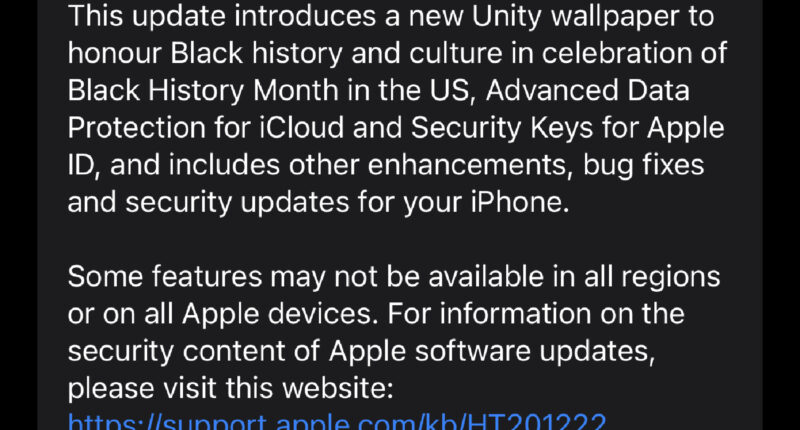APPLE has handed out a major iPhone upgrade to millions of users.
The brand new iOS 16.3 update was released overnight – and it doesn’t cost a penny.
Apple regularly rolls out upgrades to iOS, its iPhone operating system.
That’s the system that you use to navigate your iPhone, download and access apps, and everything else.
There are several new features bundled into the update, including something called iCloud Advanced Data Protection.
This means your iCloud back-ups are much more secure.


The update also includes a brand new wallpaper, fixes for a host of bugs, and some security patches.
To check for the update, go to Settings > General > Software Update.
Support!
Sadly not all iPhone owners are able to update to the latest iOS 16.3 software.
If you can upgrade to iOS 16 then you’re fine, but anyway with a very old iPhone model will miss out.
Most read in Tech
Here’s a list of all the iOS 16 (and iOS 16.3) supported devices:
- iPhone 14
- iPhone 14 Plus
- iPhone 14 Pro
- iPhone 14 Pro Max
- iPhone 13
- iPhone 13 mini
- iPhone 13 Pro
- iPhone 13 Pro Max
- iPhone 12
- iPhone 12 mini
- iPhone 12 Pro
- iPhone 12 Pro Max
- iPhone 11
- iPhone 11 Pro
- iPhone 11 Pro Max
- iPhone Xs
- iPhone XS Max
- iPhone XR
- iPhone X
- iPhone 8
- iPhone 8 Plus
- iPhone SE (2nd generation or later)
Not being able to get the latest iOS means you’ll lose access to the most up-to-date security fixes.
These are vital patches that close holes used by hackers to access your systems.
So using a very old iPhone that can’t be updated could put you at risk.
If you can’t update to iOS 16, consider upgrading your iPhone sooner rather than later.
iCloud Advanced Data Protection
Apple’s normal iCloud system is called Standard Data Protection.
It works using something called encryption, which makes your data unreadable – unless you have the right “key”.
This is to prevent anyone from snooping on your data.
Apple stores this info in its data centres, but also holds the encryption “keys” that can unlock lots of your info.
This could be backups, photos, documents, notes and more.
The idea is that it’s sometimes useful for this to be the case.
“The encryption keys from your trusted devices are secured in Apple data centers,” Apple explains.
“So Apple can decrypt your data on your behalf whenever you need it, such as when you sign in on a new device, restore from a backup, or recover your data after you’ve forgotten your password.
“As long as you can successfully sign in with your Apple ID, you can access your backups, photos, documents, notes, and more.”
There are also 14 data categories – including Health and iCloud Keychain passwords – that are totally encrypted, and Apple can’t access them.
Sadly someone else – even a trustworthy company – having your encryption keys also adds privacy risk.
Apple regularly denies requests by law enforcement to unlock iPhones.
But it can – and in many cases does – provide police with iCloud backups.
Advanced Data Protection
That’s where Advanced Data Protection comes in.
The idea with Advanced Data Protection is that the number of data categories Apple can’t access rises.
So once it’s turned on, Apple is unable to access 23 different categories of data.
It means it’s much harder for highly advanced hackers to spy on what’s inside your iCloud.
But it also stops governments from being able to request info on what you’re doing in the majority of cases.
Here’s the full list of fully end-to-end encrypted data types under Advanced Data Protection:
- Cloud Backup (including device and Messages backup)
- iCloud Drive
- Photos
- Notes
- Reminders
- Safari
- Siri Shortcuts
- Voice Memos
- Wallet passes
- Passwords and Keychain
- Health data
- Home data
- Messages in iCloud
- Payment information
- Apple Card transactions
- Maps
- QuickType Keyboard learned vocabulary
- Safari
- Screen Time
- Siri information
- Wi-Fi passwords
- W1 and H1 Bluetooth keys
- Memoji
The only three categories that don’t get full protection are iCloud Mail, Contacts and Calendars.
For everything else, Apple doesn’t hold encryption keys.
So if a police force asked for your photos, Apple wouldn’t be able to comply.
And if a hacker managed to break into Apple’s systems, they wouldn’t be able to snoop on your messages.
How to use Advanced Data Protection on iPhone
Apple rolled out Advanced Data Protection in the US with the iOS 16.2 update.
And it’s available for the rest of the world with iOS 16.3.
The obvious problem with advanced Data Protection is that Apple will struggle to help you recover your account.
So you need to set up extra safeguards before you turn it on, otherwise you risk being locked out of your account.
That means setting up Account Recovery.
You’ll need to goto Settings > iCloud > Advanced Data Protection.
Then tap up Account Recovery to make sure your account is restorable.
This could mean adding a recovery contact who can help you unlock your account.
Or it could mean generating a 28-character recovery key that you need to write down – helping you eventually unlock your account.
Once you’ve got Account Recovery enabled, you can then turn on Advanced Data Protection.
This should significantly improve your privacy, especially if you have lots of info saved to iCloud.


Just don’t fall out with your recovery contact, or lose track of that 28-character key.
Best Phone and Gadget tips and hacks

Looking for tips and hacks for your phone? Want to find those secret features within social media apps? We have you covered…
We pay for your stories! Do you have a story for The Sun Online Tech & Science team? Email us at [email protected]
This post first appeared on Thesun.co.uk









